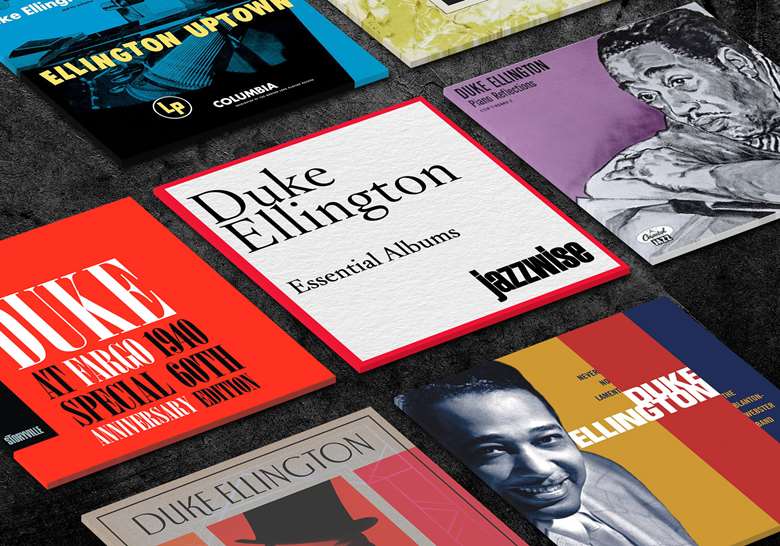Duke Ellington: 10 Essential Albums
Brian Priestley
Monday, February 5, 2024
A great introduction to just a few of Duke Ellington's finest moments on record selected by Brian Priestley

The Duke Ellington discography is vast – countless 78s and hundreds of albums. So how do you start? Our Ellington expert Brian Priestley is your guide – here he selects 10 crucial albums which should form the cornerstones of your collection...
1. Ellington In Order Vols.1-5
Sony/BMG
The move towards streaming seems designed to encourage background listening, rather than study. But – and it’s a big but – just in the last few months, some 250 tracks from Ellington’s 1927-33 period have become available in this medium. Almost everything from early versions of ‘Black And Tan Fantasy’, ‘Creole Love Call’ and ‘The Mooche’; to obscurities previously only found on multi-CD collections are all now online chronologically. You might need a couple of books to help sort the essential from the merely interesting, but extensive discographical details have been assembled online at: www.ellingtonlive.blogspot.com
2. Never No Lament: The Blanton-Webster Band
RCA Bluebird
Most of Ellington’s 1930s records are currently out-of-print, until the above In Order series catches up. However, his 1940 change of label, bringing enhanced sound quality, underlines his development thus far. The reissue album is aptly subtitled, since Jimmie Blanton and Ben Webster had both just joined, Blanton dying from TB two years later and Webster leaving soon after. Contrasting masterpieces like ‘Ko-Ko’, ‘Jack The Bear’, ‘Concerto For Cootie’ and ‘Cotton Tail’ were all made in the first couple of months, and listing the remaining highlights would fill the rest of this page.
3. The Duke At Fargo 1940
Storyville
The North Dakota town, celebrated by the Coen brothers, is almost a byword for the boondocks, but it was just another stop on the Ellington band’s itinerary. It was also where two local amateur recordists cut acetates, with Duke’s permission, of a whole evening’s dance date. As well as a landmark achievement, it shows the band 'at work' with the leader programming his newest RCA instrumentals alongside familiar oldies, with few vocals and few non-Ellington items.
4. Carnegie Hall Concert 1943
Prestige
Another live event, but also a major achievement. Much of the programme is not dissimilar perhaps to a gig such as Fargo, yet for Ellington’s debut appearance at the renowned concert-hall he produced his most extended work so far. The 50-minute ‘Black, Brown and Beige’ described Afro-American history from slavery to the hoped-for improvements of the 20th century, and did so in musical terms that contain many memorable moments.
5. Ellington Uptown
Columbia Legacy
Supposedly illustrating a less successful period, this 1952 band had lost Johnny Hodges and a couple of other long-standing sidemen, but it had gained the likes of Clark Terry and Louie Bellson. The latter’s self-composed feature ‘Skin Deep’ was the selling-point, but there were extended re-makes of ‘Perdido’ and ‘Take The A Train’ (with an introductory piano solo soon to be heard nightly on the Voice Of America radio station), and the tightly-composed 14-minute ‘Tone Parallel To Harlem’. The CD reissue also adds the tongue-in-cheek ‘Controversial Suite’ and 1947’s ‘Liberian Suite’, commissioned to celebrate the centenary of the African nation’s founding.
6. Piano Reflections
Capitol
From the same 'less successful period', this 1953 trio session was originally a 10-inch LP called The Duke Plays Ellington, including the boppish ‘Who Knows?’, and then added from the same date to make a 12-inch were tracks such as ‘Melancholia’. Finally, from later the same year, the original version of ‘Kinda Dukish’ was one of the items appended for the CD reissue.
7. At Newport
Columbia Legacy
The justly celebrated LP from Ellington’s Newport festival debut was the first to be deliberately conceived as a live album. The opening side had new material (that was actually re-recorded a couple of days later) while the reverse had the famous contrast between the updated ‘Diminuendo And Crescendo In Blue’, originally from 1937 (but now featuring Paul Gonsalves and his 27-chorus solo), and the dead-slow ‘Jeep’s Blues’ revival celebrating the return of Johnny Hodges. The CD edition also has all the material performed that wasn’t on the original LP.
8. Money Jungle
Blue Note
It was producer Alan Douglas’ idea to place the 63-year-old pianist in a trio alongside younger composer-bandleaders with fully-formed styles and reputations of their own (who had both briefly worked under him, Max Roach for a week, Charles Mingus for a month). Apparently, Ellington discussed his ideas in conversation and then everything was put together in the studio, including the famous ‘Fleurette Africaine’ where, in his subsequent description, “Our three muses were one and the same. There was just one take, and I was thrilled.”
9. Duke Ellington and John Coltrane
Impulse!
A mere nine days after the session above, Duke was freelancing before joining Sinatra’s Reprise label, and arguably less forthcoming than in the trio with Mingus and Roach. Naturally, Coltrane as the front-line was more dominant but Ellington’s comping and soloing is wonderful and, as well as creating new intros to ‘My Little Brown Book’ and ‘In A Sentimental Mood’, he moves the latter from its perennial key of F to D-flat, where Trane’s tenor sits better.
10. The Far East Suite
RCA Bluebird
Mostly conceived after a State Department tour of the Middle East; but expanded by the 11-minutes-plus, Japan-inspired ‘Ad Lib On Nippon’ and a couple of later pieces, this 1966 album is a tour de force for the band, the soloists and Duke the piano player. It also shows how naturally Ellington could absorb ideas from other cultures and make them his own – hardly surprising perhaps from the man who facilitated the 1936 barrier-breaker called ‘Caravan’.
This article originally appeared in the December 2023 issue of Jazzwise magazine. Never miss an issue – subscribe to Jazzwise today



